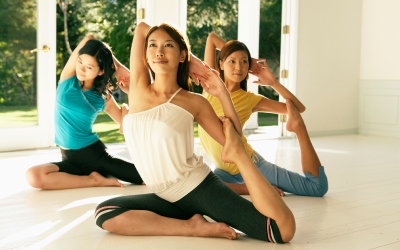Vinyasa Yoga and Health: The Subtler Side
Article by Carly Budhram: Ten years ago, the practice of yoga tumbled into my life and never left. I had already spent years modifying my diet and performing cardiovascular exercise from an initial desire to be thinner; over time, I learned that there were other valuable benefits to exercise that I came to want even more. Energy! Focus! Mood boosting! And above all, the power to fight stress of all kinds – work; family and friends; anxiety and depression; major life decisions and changes.
Yoga took this revelation to a new level; I gained a deeper, more subtle, and more powerful experience of improving my own health. It brought together an awareness of the body and the mind, something I knew I loved – but also introduced the heart. Pattabhi Jois said that “Vinyasa” means “to place in a special way.” This can be attributed not only to careful alignment of our bodies on the mat, but to exploring our thoughts and the effects they have on us; choosing carefully when we express how we feel. With careful attention to the movements of our mind and heart via linking breath to asana, we can explore and refine how we see and hold ourselves, as well as how we relate to the world. As we learn to become more easeful in postures, we also develop an internal capacity for comfort with our external lives and who we are in them.
I would like to highlight three ways in which I’ve found Vinyasa yoga can become a playground for well-rounded, healthful living:
Strength. We learn to specifically align our bones so that we can derive optimal use of our muscles. We pull energy into our bodies to stabilize, ground, and center. This helps us endure longer holds, as well as retain our focus when we’d much rather leave the pose. This training in endurance can further allow us to diligently stay with feelings that are uncomfortable. Instead of pushing them away, we courageously “stay in the fire,” diving deeper into what is scary, and get to understand our fears better. Creating a solid, secure center is the foundation for developing receptivity to exactly how we show up, in all our forms, light and dark. We have to practice in order to build our mental and emotional “muscles” as much as the ones just below our skin.
Flexibility. The most commonly accepted reason to practice asana today is to find more physical flexibility. We make our muscles more pliable so that we can move through our daily tasks with ease and comfort. The same is true for softening our rigid thinking about “right” and “wrong” ways to tackle problems. We can get creative and find more nuanced, unique, and appropriate ways of handling life. We practice a sense of grace as we flow from one posture to the next, without holding on to how it should feel or look, and in the same way we can find a fluidity in our response when the universe hands us something we wouldn’t have chosen for ourselves – a sudden financial struggle, an unexpected death of someone near to us, an illness that prevents us from carrying on as we’d planned. We find acceptance – whether it be of the uncooperative body part or the emotionally taxing family member – and soften into the truth that we must relinquish control where it cannot be held, that our own response is where the work belongs.
Connection. One definition of yoga is to “yoke.” This can be thought of in a few ways, one being a relationship between our bodies, our thinking, and how we feel. On a gross level we may realize that sitting in a slouched position at work reduces our physical capacity to breathe and subsequently drains us of our energy and motivation. We are left feeling sluggish and foggy, or over longer periods even depressed. On a subtler level, yoga shows us that we often round the shoulders down and forward as a way of shielding the heart from pain. Opening and lifting the chest, allowing space for our breath and life force to flood and move us, can ultimately be the path to shedding our armor, healing our wounds.
Another way to think of connection is in the context of our relationships. The internal work we do to become stronger, softer, and more responsive to ourselves translates directly to treating others with the same love-filled respect. We extend a sensitivity and empathy to others. And when others hurt us, we can retain our stability and fluidity in the face of pain. This is where we practice yoga off the mat – through the repeated experiences of relating, loving, and being hurt. We are patient and willing, but know when to firmly, courageously put ourselves first. We are vulnerable and intimate, bringing richness to our relationships. We give equal space to sadness or anger as we do to joy and love. We become resilient. We grow. Sounds like health to me.
Yoga helps us step into a deeper listening, to ourselves and others, so that we may be more efficient with our energy and relaxed in our experience. After some time spent with the practice, a lithe body, improved heart function, and injury prevention (among a host of other benefits) seem to be the cherry on top.


Comments are closed.